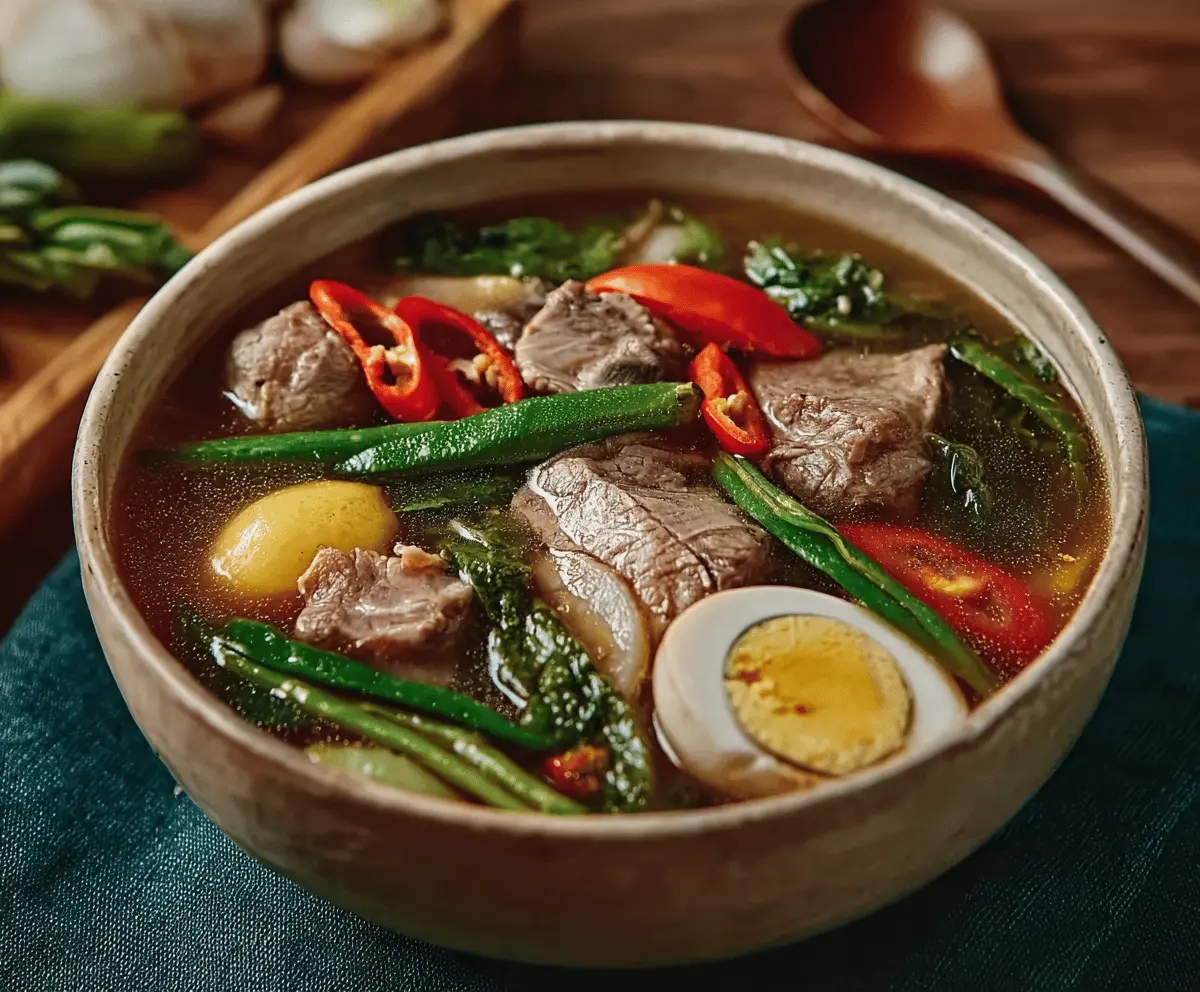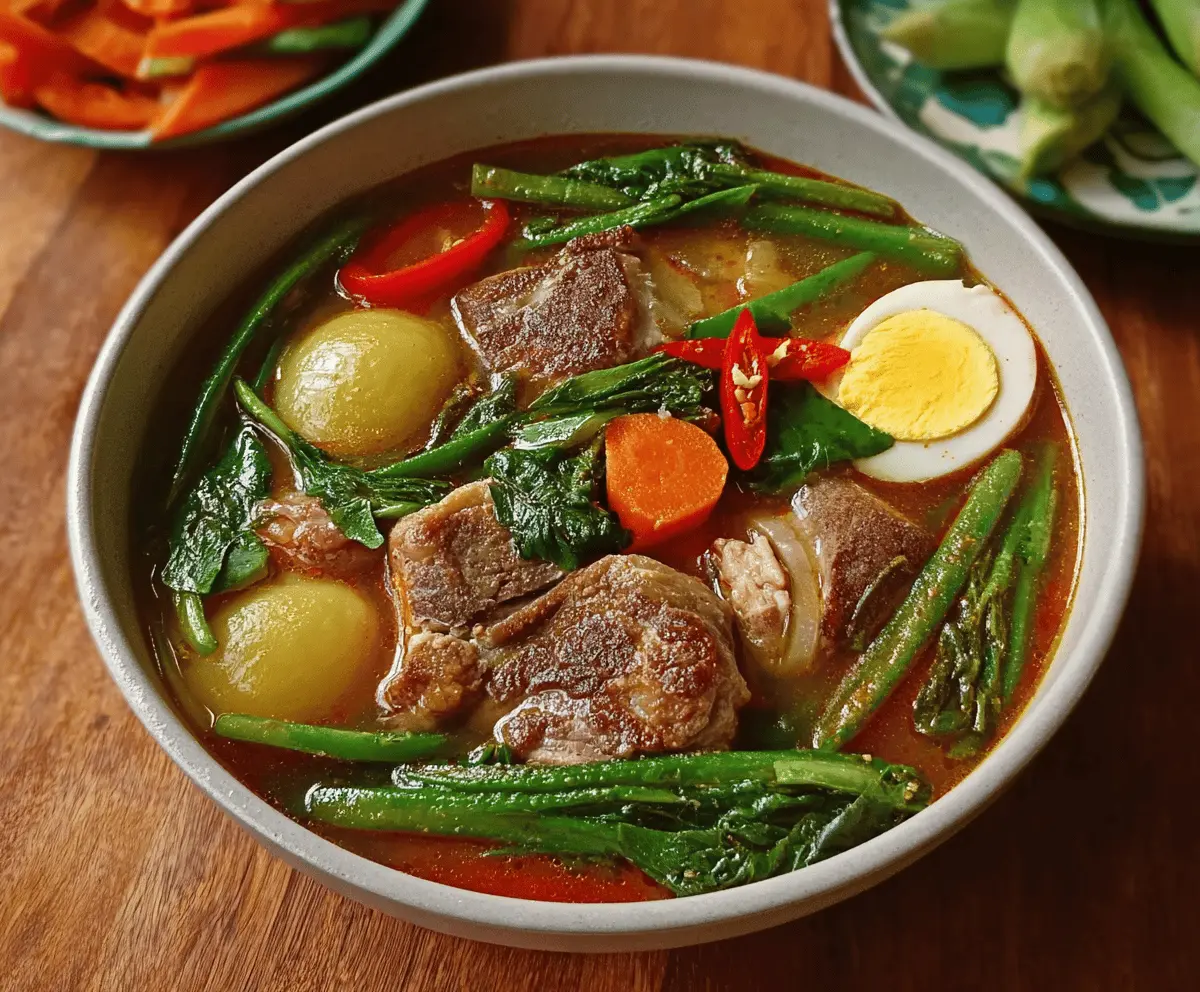Pork Sinigang is a warm and tangy soup that will make you feel cozy. Made with tender pork, sour tamarind, and fresh veggies, it’s packed with flavor!
I love how the sourness wakes up my taste buds. It’s perfect for chilly days when you just need a big bowl of comfort. Plus, who doesn’t love slurping noodles? 😋
Key Ingredients & Substitutions
Pork: Pork shoulder works great for a tender bite, but ribs also add extra flavor to the broth. If you’re looking for a leaner option, use pork loin instead—but it won’t be as rich.
Tamarind: Tamarind gives that signature sourness. If you can’t find fresh tamarind, the packaged sinigang mix is a good alternative. Some like using lemon or lime juice as a substitute for a more citrusy tang.
Vegetables: Daikon radish and taro roots are traditional choices. However, you can easily swap them for carrots or even potatoes if they’re more accessible. Just remember that cooking times may vary.
Greens: Kangkong is popular, but spinach is a great, easy substitute. It adds color and nutrition but cooks much faster, so add it at the very end!
How Do I Make Sure My Pork is Tender?
Getting perfectly tender pork in sinigang is all about the simmering step. Patience is key here! Cook the pork slowly to break down the connective tissues.
- Start with boiling the pork in water. Skimming off the scum will give you a clearer broth.
- Lower the heat and keep it at a gentle simmer; this helps keep the meat juicy.
- Check for tenderness after about an hour, and adjust time as needed—it could take more time depending on the cut!
What’s the Best Way to Balance the Sourness?
Finding the right balance of sourness can make or break your sinigang. If you find it too sour, you can dilute it with a bit of water. On the other hand, a little extra tamarind or more soup mix can crank up the flavor. Trust your taste buds!

How to Make Pork Sinigang
Ingredients You’ll Need:
For the Soup:
- 2 lbs pork shoulder or pork ribs, cut into chunks
- 8 cups water
- 1 medium onion, peeled and quartered
- 2 medium tomatoes, quartered (optional)
- 2-3 pieces green chili peppers
- 1 medium daikon radish or 2 medium carrots, peeled and sliced
- 1 cup sitaw (string beans), cut into 2-inch pieces
- 1 medium taro root, peeled and cut into chunks (optional)
- 1 bunch kangkong (water spinach) or spinach leaves, washed
- 1 pack tamarind soup base mix (sinigang mix) or 1 cup fresh tamarind juice
- Fish sauce (patis) or salt, to taste
For Garnish (Optional):
- 2 hard-boiled eggs, halved
- 1 red chili, sliced
How Much Time Will You Need?
You’ll need about 15 minutes to prepare the ingredients and around 1.5 to 2 hours for cooking. This includes simmering the pork until it’s tender, plus some time for the vegetables to cook just right!
Step-by-Step Instructions:
1. Boil the Pork:
In a large pot, add the pork chunks and pour in the 8 cups of water. Bring this mixture to a boil over medium-high heat. Don’t forget to skim off any scum that rises to keep your broth nice and clear.
2. Add Aroma:
Once boiling, toss in the quartered onion and tomatoes (if you’re using them). Lower the heat to medium and let it simmer for about 1 to 1.5 hours, or until the pork becomes tender. Make sure to check occasionally!
3. Add the Vegetables:
Now, it’s time to add some healthy crunch! Add the green chili peppers, daikon radish or sliced carrots, taro (if you want), and sitaw (string beans). Let it cook for another 10-15 minutes until the veggies are tender, but still crisp.
4. Bring in the Sourness:
Stir in the tamarind soup base mix or the fresh tamarind juice. Adjust the sourness to your liking! If it’s too sour for your taste, just add a bit more water until it’s perfect.
5. Season it Up:
Add fish sauce or salt to taste. Give the broth a taste and see if you’d like to add a bit more seasoning for flavor. You want it just right!
6. Final Touch:
Add the kangkong or spinach leaves last, cooking for just 1-2 minutes until they are wilted and vibrant green.
7. Serve it Hot:
Ladle the sinigang soup into serving bowls and garnish with halved hard-boiled eggs and sliced red chili if you’re feeling fancy.
8. Enjoy!
Serve your delicious Pork Sinigang hot, alongside some steamed rice. It’s a comforting dish sure to warm your heart!
Enjoy your hearty and sour Pork Sinigang!

Can I Use a Different Cut of Pork?
Absolutely! While pork shoulder and ribs are traditional, you can also use pork belly or loin for a leaner option. Just keep in mind that cooking times may vary based on the cut, so check for tenderness as you cook.
How Do I Store Leftover Sinigang?
Leftover Pork Sinigang can be stored in an airtight container in the fridge for up to 3 days. Reheat it on the stove or in the microwave, adding a splash of water if it thickens too much.
Can I Make Sinigang Vegetarian?
Yes, you can! Simply substitute the pork with tofu or your favorite vegetables, and use vegetable broth. You might still want to use the tamarind for that signature sour flavor.
What Can I Serve with Sinigang?
Sinigang is best enjoyed with steamed rice, but you can also serve it with noodles or a side of fried fish for a complete meal. Add some fresh side salad for extra crunch!


